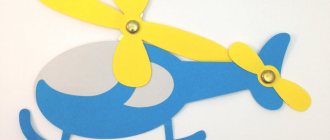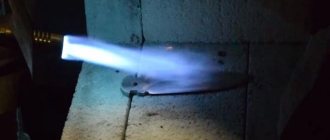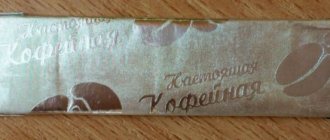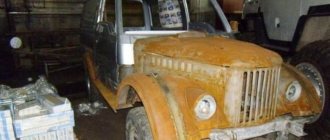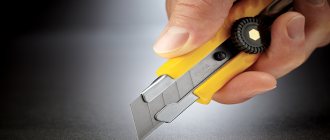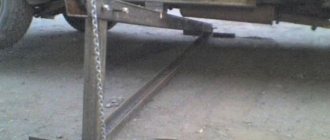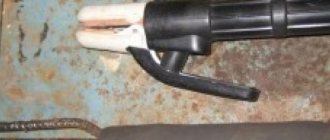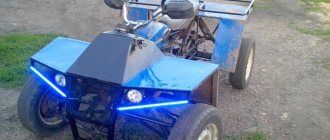This device has a dual purpose. It can be used to find the center of a round workpiece; also, using a series of holes, it is possible to mark circles and arcs of various radii.
Cut out a block of the specified size from 19 mm material and shape it in accordance with the drawing. Using a hacksaw, cut off a piece 305 mm long from an aluminum strip with a cross-section of 3×25 mm. Mark the centers of the holes as shown in the figure. Using a drill press, make three through holes for the screws and countersink them. Then drill a series of marking holes at equal intervals and a center hole. Holes drilled into aluminum often have burrs on the edges, so we recommend sanding the piece smooth with 220-grit sandpaper.
Using a square, position an aluminum straight edge perpendicular to the bottom edge of the block, aligned with the top of the triangular cutout. Drill guide holes in the wooden block through the countersunk holes of the ruler and fasten both parts with screws.
How to use this tool
To find the center of a round object, such as the turning piece shown in the top photo, rotate the center finder block around it and draw two lines along the ruler, intersecting at approximately right angles. The point of intersection of these lines is the center of the circle.
To make the tool act as a compass, insert an awl, nail or other pointed object into the axial hole. Using one of the holes in the row, rotate the tool around the pivot point to draw a circle or arc.
Can be used to find the center of a round workpiece, as well as to mark circles and radii. It has a simple design and is not difficult to make.
It consists of an aluminum strip and a wooden block.
Assembly of the device.
First, a rectangle of the required size and shape is cut out of a wooden blank:
Then a piece 305 mm long is cut out of a 3x25 strip of aluminum. 3 mounting holes for screws, one axial hole and 20 marking holes are drilled in it. Their size and position are shown in the figure:
When drilling holes in aluminum, burrs may appear on their edges; to eliminate them, it is recommended to sand the workpiece with fine sandpaper.
When attaching an aluminum strip to a wooden block, it is very important to accurately maintain an angle of 90 degrees with respect to its lower edge; the accuracy of the marking will depend on this. This can be done using a square. The edge of the strip should exactly coincide with the top of the triangular cutout in the block.
After marking, the strip is attached to the block with 3 screws. The axial hole is made through. The device is ready!
How to work with the device.
Center finder.
To find the center of a round object, you need to place the center finder on the top of the workpiece, pressing it firmly against the surface of the object being measured. Next, you need to draw a line along the ruler on the workpiece, rotate the center finder 90 degrees and draw a second line. The points of contact of these lines will be the exact center of the workpiece.
Compass.
Of course, the device is inferior in functionality to a real compass (since it has a rather large marking step), but it can still be used to mark circles of a certain radius.
To do this, any sharp object of suitable diameter (awl, nail, etc.) is inserted into the axial hole of the device. A marker or pencil is inserted into one of the marking holes.
“From the presented material you will learn how you can make a center finder yourself using improvised means. Every craftsman simply needs a reliable and convenient tool for marking and finding the center on workpieces. You can buy such tools in a store, or you can also make them yourself. What you need is a piece of plywood and an aluminum plate 305 mm long and 25 mm wide. Holes for fastening 3 pieces and 20 holes for marking are also drilled.
The design of the center finder is quite simple, to understand the essence, let's look at the drawings. Based on the drawing data, it is necessary to cut a wooden block according to the presented dimensions, then an aluminum plate 305 mm long and 25 mm wide. It is necessary to drill 3 holes in the plate for fastening, 1 guide and 20 holes on the ruler itself for marking. Everything is assembled into a single structure. In addition to finding the center of round workpieces, you can also draw a circle (example in the photo below). To mark the center, press it tightly to the workpiece and draw a line with a pencil, then turn the center finder 90 degrees and draw another line, the place of the crosshair will be the center of the part . Here is such a simple and necessary tool for your workshop, you can make
One of the most important operations when working on milling equipment is determining the preparation center. This is especially true for the manufacture of piece goods. Processing them by trial and error will not give the desired result. To perform this work, a special module is required - a center finder.
Purpose of center finders for milling machines
The main task of this tool is to align the base point of workpiece processing with the spindle axis. This can be not only the center of the part, but also any area that needs to be milled.
Special equipment is used to process large parts. In addition to the milling machine, portable radial drilling machines are used to determine the center. However, for small piece products this approach is not possible. The best option is to install a center finder on the spindle head.
This additional equipment will allow you to perform the following operations with high accuracy:
- milling the center of the part to form recesses of various configurations;
- production of channels on the end part. The center finder will determine the distance from the processing area to the center with maximum accuracy;
- performing radial drilling operations for complex workpieces whose surface curvature consists of several radii.
Center finders are not included in the standard equipment of the machine. Performing standard operations is done using factory models. If mass processing of complex workpieces is required, the device for determining the center is made to order.
Cutters for boring heads
All cutters, regardless of type, consist of a holder on which the cutting element is attached. The holder is mounted on the standard place of the working equipment. The structure of the cutting element, which is called the head, has its own characteristics:
- Solid heads are made from high-quality tool or high-speed steel. This type of design does not provide for division into a holder and a cutting element. Very rare due to high cost.
- The working part is a soldered plate made of a high-strength alloy, which contains various additives that improve the quality of the material. The most common type.
- There are designs in which the cutting plate is attached to the holder mechanically. This method is used for cutting parts made of metal-ceramic materials.
Boring heads differ according to the method of application:
- For blind holes.
- For through holes.
There are also universal boring cutters, which provide for the installation of replaceable inserts of various shapes, which allows you to perform a variety of work with the same holder.
DIY center finder
Often, when working with carpentry, you are faced with the problem of finding the center of a round part, be it the end of a log or a sawn blank, a lid...
In order not to have to worry about markings every time, I suggest making a simple center finder with your own hands from a board and a strip of metal.
The drawing and manufacturing procedure are clear from the photo below.
But I will add about manufacturing. Let me start with the fact that firstly, this dual-purpose center finder, in addition to searching for a point in the center of a circle, it can also draw them (it has a number of drilled holes for different radii)
For production you will need: - 20 mm board or plywood. thickness. — Metal strip 3*25*305 mm. - Three self-tapping screws - And a tool - a ruler, a pencil, a hacksaw, a drill, a screwdriver.
1. Take a 20-gauge board or plywood. In the drawing there is a 19-piece because the part is polished. Next, we draw and cut out the required shape - see the picture.
2. Now let’s move on to a strip of metal , it’s better, of course, if it’s aluminum, it’s easy to work with - it’s easier to process. In general, we cut off a strip 30.5 cm long and 25 mm wide. If there is no suitable one, then cut it out of the sheet using a grinder.
The basis of the tool is a corner
To make it you will need an ordinary construction corner. It costs pennies at any hardware store. The master found it surplus and will use it.
Electrical tape is needed to ensure that the cut is as smooth as possible.
To avoid injury, we smooth out all sharp corners and edges. We take a two and a half millimeter drill and make three holes. It is advisable to do all this carefully. If you have a machine, then use it better.
We apply any solvent that is available to the cotton wool and degrease it. You need glue to hold everything securely in place. Add a little water, since the stainless steel from which the homemade center finder will be made is quite difficult to drill. We will use the same drill for two and a half mm.
Homemade center finder: manufacturing process in detail
3 weeks ago I saw a center finder on a chipmaker made by the user Starik. I set out to make the same one. For more convenient work.
Sketches were made using the available 3D images and work began.
1. Probe with contacts
The probe with the ball is machined from 12x18n10t (stainless steel), it is mounted in a caprolon tee on an M4*0.7 thread. Contacts with a diameter of 3 mm are also made of stainless steel and are tightly seated in the holes of the tee. It is better to drill holes for the contacts with a 2.9mm drill. In any case, the hole will be slightly broken and the contacts will fit tightly. On the side of the tee that we cannot see there is a cylinder with a diameter of 5 mm. 1mm high. to hold the spring
The spring is made of OVC with a diameter of 0.4 mm. No lathes were used for coiling. Only a drill with a diameter of 4.8 mm and a vice. It is better to remove the flats at the ends of the spring so that these flats lie in parallel planes. This will increase reliability.
Made of plexiglass, diameter 35mm. Threaded holes for attaching a cover made of D16T. Holes with counterbore for position adjustment screws (edge finder adjustment) Recesses at 120 degree angles. for stainless steel contacts Through hole with a diameter of 2.8 mm in the center for installing a ball with a diameter of 3.2 mm on the side of the case that we cannot see
Holes with countersink for M3 mounting screws Holes without countersink with a diameter of 3.2 mm so that a wrench can be inserted for adjustment
Fastening cylinder 25mm long with a diameter of 8-0.02mm M3 holes for adjusting screws A blind hole in the center with a diameter of 2.8mm for installing a ball with a diameter of 3.2mm. The ball is used as a support when adjusting the center finder
6. Printed circuit board
Scheme
Made by LUT from one-sided textolite
Parts list of SMD parts:
1. single Schmidt trigger 74ahc1g14 2. output field switch - 2N7002 3. resistors next to the LEDs 300 Ohm 4. 2 multi-colored LEDs 5. resistor 5-10 kOhm 6. capacitor 0.1 uF
!Important! Do not under any circumstances use copper-plated balls from hunting stores! I used 3mm diameter balls. from bearings.
And a photo of the finished center finder
_______________________________________________________________________________
We've sorted out the hardware, let's move on to the software part
1. I didn’t need the offline button in Mac anyway, so I redid it
2. To work with the center finder, I wrote my first script script
3. After finding the center and zeroing the X and Y coordinates, 2 such messages are displayed with the hole lengths in X and Y
The hardware is ready, the script is written, let's try it
A small addition: It’s better not to use the same wire as mine to connect. Buy wires with connectors for connecting servos at some ship/aircraft/automotive store, connect the connector as mono closer to the device - it will be both beautiful and convenient.
Chronicles of a Freelancer
I wanted to finish one part, so I purchased a boring head for a km2 cone and a 6 mm cutter. Unfortunately, as always, they sold a slightly broken one (the clamping screw for the cutter needs to be changed). Well, there were no square keys in the kit, I knew that in advance. The price was 5 times cheaper than a new Chinese product.
I took it apart and lubricated the inside. cleaned and assembled. The head is well made and the assembly accuracy is remarkable. But the cutter is not clamped properly, so it is not yet possible to work. The culprit is a broken installation bolt. The problem is that the thread of the set screw is non-standard M8*1.00*10mm. I just couldn't find it. I'll probably cut a standard one there or grind another one. Fortunately, after “Tavria” I still had a set of “non-standard” dies.
“Sharpened” a couple of incisors. They were originally 12mm. On the first one, when boring, it gave too much load (1mm removal from a radius of 1000 rpm) and broke it. The second one was made with a notch. The holder is made of ordinary steel. It is unclear why it was blackened out.
In short, I liked the tool, it adjusts well and smoothly in diameter. It’s fashionable to make holes from 7 mm, it seems. I haven’t measured it exactly, but based on duralumin, it’s quite convenient and pleasant to work with.
Upd. I started making a set screw M8*1.00. The price for 5 of these screws on eBay, if with delivery, is off the charts at $16. If you need it, you should search by the phrase - M8 x 10mm Metric Fine Pitch 1.0 Socket Grub Screws. Of course, I won’t make such a super bolt, but the cost of doing it will be about 7 hryvaks. And that’s because I used a bolt from USP12 as a blank. Actually, there was nothing else at hand. But I wanted it to be faster. The bolt, it turned out, had not been hardened even once and went through smoothly. Now all that remains is to cut the m8*1 thread. I will do this with a die, although it is non-standard, it is clearly not worth 16 dollars.
It has already been machined to a diameter of 8.0 mm. By the way, finally, after Leontyev’s lectures, it dawned on me that the machine was removing the diameter. I still couldn’t understand.
By the way, cutting such blanks is very difficult. The machine does not “pull”. You'll probably just have to cut it with a cutting disc; it works very well in the proxon.
- Universal dividing heads udg, udg-d, f11, f12, fw, fb, fnl, fk
Upd. Probably I was in the right mood, I found an M8*1 die and cut it normally. The carving was made by clamping the die between the lathe's head and the set chuck in the tailstock. It turned out pretty good. To be honest, I don’t know how else to cut it just as accurately without changing the gears in the guitar (I haven’t changed them yet). As a result, I have a working boring head.
On the left is the screw that was made, on the right is the one that came with the head. I made it for a simple straight slot, I have absolutely no idea how you can make a 5*5 mm square hole. Probably hollow it out somehow.
New screw in boring head.
View from above, protrudes a little more, although this is fixable, in principle. If it gets in the way, I’ll make the second option, shorter. A piece of the USP12 screw still remains.
These are the things, all that remains is to make or buy a couple of 4*4 square keys to move and fix the head.
Upd. In addition, I had to shorten the holder a little, first in the grinding machine, then clamped it in the lathe and
How to choose a drill for a dowel?
I removed a couple of millimeters, then washed the hole with alcohol and lubricated it.
It turned out that the maximum machining hole at the head is 30.5 mm. Let's just say a little. I would like twice as much.
The quality of surface treatment is excellent. Especially large holes. On smaller ones, it is obviously necessary to increase the rotation speed on finishing passes, or the feed rate. The head is adjustable in hundredths of a millimeter according to the removal diameter.
It is probably also possible to machine the holder with an offset of up to 6 mm, which would give an additional 6 mm to the removal diameter, but I did not have a 4-jaw turning head at hand.
If you find an error, please select a piece of text and press Ctrl+Enter.
Purpose of center finders for milling machines
The main task of this tool is to align the base point of workpiece processing with the spindle axis. This can be not only the center of the part, but also any area that needs to be milled.
Special equipment is used to process large parts. In addition to the milling machine, portable radial drilling machines are used to determine the center. However, for small piece products this approach is not possible. The best option is to install a center finder on the spindle head.
This additional equipment will allow you to perform the following operations with high accuracy:
- milling the center of the part to form recesses of various configurations;
- production of channels on the end part. The center finder will determine the distance from the processing area to the center with maximum accuracy;
- performing radial drilling operations for complex workpieces whose surface curvature consists of several radii.
Center finders are not included in the standard equipment of the machine. Performing standard operations is done using factory models. If mass processing of complex workpieces is required, the device for determining the center is made to order.
Design features of boring heads
The design of the tool allows you to place several cutters at the same time. Practice has shown that the optimal number of cutting elements is 2, provided they are located radially. This configuration has the following advantages:
- Thanks to the balanced arrangement, machining accuracy is improved.
- The vibration level is reduced.
- The dynamic performance of the machine is improved.
Increasing the number of incisors negatively affects the balance of the head. As a result, boring operations will not have high accuracy, especially at high speeds, which reduces the productivity of the machine.
The boring head is mounted on a metalworking unit on a spindle shaft, which transmits rotational torque from the machine drive. To prevent the head from flying out during operation, the tool is secured with screws or nuts.
The main components of the boring head are:
- Hub. As the name suggests, the hub is mounted on the machine spindle using a shank. For reliable fastening there are four screws, two of which secure the quill in parallel.
- Pinol. Mounting location of the working cutter of the boring head.
- Crawler. Movable element of the quill. The movement is carried out by rotating the drive screw. Serves as an adjustment mechanism for aligning the incisors to the centers.
- Shank. Unit for transmitting torque from the spindle part to the cutting elements.
Types of center finders
Before choosing the optimal center finder model for the machine, it is necessary to determine the required accuracy parameters. However, it should be taken into account that the smaller the error, the greater the complexity of manufacturing one part.
Experts do not recommend the use of homemade center finder models. They will not be able to provide adequate measurement accuracy. The best option is to purchase a factory design that complies with regulatory documents - GOST 25827-93.
With indicator
The design of the indicator center finder consists of a cone-shaped mounting unit attached to the spindle head. There is a horizontal rail on it, along which the position meter moves relative to the center of the part. It is an indicator in contact with a spring-loaded lever.
The advantage of an indicator center finder for a machine tool is its high measurement accuracy. To perform the work, it is mounted on the spindle head. It must have the function of changing its position along the x axes; y. After installing the device, an initial determination of the center of the part is performed. Then the position of the spring-loaded lever changes, it rests against the measured edge of the workpiece. The required degree of change in the location of the spindle head is determined by the indicator.
Features of the design:
- maximum measurement accuracy;
- it takes a lot of time to configure the device to the parameters of a specific part;
- the ability to accurately determine the processing location relative to the center.
You can make an indicator center finder yourself. But to achieve the required accuracy, you should purchase a factory spring-loaded lever and indicator.
The most popular model is CI-03-0.01. Its average cost is 5,000 rubles.
Center finder mandrel
To accurately determine the center of the workpiece, you can use a simplified model of a center finder. It consists of a housing, on the end of which there is a sliding ring. Thanks to the spring, it can change its location relative to the central axis of the vertical body.
During operation, the ring is shifted relative to the center of the mandrel. When the spindle rotates, a beating is visually observed. By changing the position of the part, runout is reduced. This way the center of the workpiece is determined, the maximum measurement accuracy is 0.01 mm.
The disadvantage of this technique is the limitation on the shape of the parts. It is also impossible to determine the center when measuring the sides internally or externally.
Optic
The optical type of the center finder allows you to enlarge the marking lines marked on the surface of the part. For this purpose, the design provides a lens system, one of which has a crosshair.
Such models are designed for milling microscopic elements. To determine the processing location, the crosshair on one of the lenses must coincide with the marking lines on the part. Then the center finder is removed from the spindle and a cutter is installed in its place.
The video shows the operating instructions for the indicator model of the center finder:
Principle of operation
The diameter of the hole produced by drilling is limited. To increase it, boring is done.
A boring head is mounted in the spindle. The cutter is inserted into the groove of the slide, the cutting edge is aligned along the axis of rotation. The lead screw moves the tool to the desired size - hole plus cutting depth.
When the spindle rotates, the part fixed on the table moves towards the bed. A cutter rotating in a circle processes a hole to a given size. Then the slider moves outward, and so with each pass chips are removed, increasing the size of the internal cavity.
Boring of small diameter holes is carried out using end cutters with a long mandrel stem. It is inserted into the end of the slide. Boring to the required size is ensured by changing cutters with different head sizes. Such tools are sold in sets indicating the minimum and maximum diameters.
Bored holes are divided into:
They are bored with one type of head, only the cutters are changed. For through passage, regular gateways are installed. The bottom of blind cavities is cleaned with end cavities with 2 cutting edges.
According to the mechanism of operation and adjustment, boring heads are divided into:
- with manual feed;
- automatic.
Each type has its own advantages.
With manual feed
The machine operator moves the slide with the cutter fixed in it manually, turning the lead screw with a wrench. In simple devices, after each pass the screws are released, the cutter is moved to the depth of the cut, and the fasteners are tightened again.
You can make such devices yourself. They are tough, simple, and capable of removing a thick layer of metal in one pass. It is difficult to catch a size with an allowance of 0.005 mm using a manual feed head. Using boring heads with manual feed, only holes with smooth surfaces of the same size are made.
With automatic radial feed
Automatic feeding is carried out due to a special clutch that, when turned on, transmits rotation from the spindle to the lead screw. This allows you to change the position of the cutter in any area along the length of the hole and make grooves, cones, and figured cuts.
Devices with automatic radial feed of the slider - cutter, are less rigid. They remove no more than 0.02 mm of metal in one pass. The adjustment accuracy is high, up to 0.002 mm.
Purpose of center finders for milling machines
The main task of this tool is to align the base point of workpiece processing with the spindle axis. This can be not only the center of the part, but also any area that needs to be milled.
Special equipment is used to process large parts. In addition to the milling machine, portable radial drilling machines are used to determine the center. However, for small piece products this approach is not possible. The best option is to install a center finder on the spindle head.
This additional equipment will allow you to perform the following operations with high accuracy:
- milling the center of the part to form recesses of various configurations;
- production of channels on the end part. The center finder will determine the distance from the processing area to the center with maximum accuracy;
- performing radial drilling operations for complex workpieces whose surface curvature consists of several radii.
Center finders are not included in the standard equipment of the machine. Performing standard operations is done using factory models. If mass processing of complex workpieces is required, the device for determining the center is made to order.
Types of center finders
Before choosing the optimal center finder model for the machine, it is necessary to determine the required accuracy parameters. However, it should be taken into account that the smaller the error, the greater the complexity of manufacturing one part.
Experts do not recommend the use of homemade center finder models. They will not be able to provide adequate measurement accuracy. The best option is to purchase a factory design that complies with regulatory documents - GOST 25827-93.
With indicator
The design of the indicator center finder consists of a cone-shaped mounting unit attached to the spindle head. There is a horizontal rail on it, along which the position meter moves relative to the center of the part. It is an indicator in contact with a spring-loaded lever.
The advantage of an indicator center finder for a machine tool is its high measurement accuracy. To perform the work, it is mounted on the spindle head. It must have the function of changing its position along the x axes; y. After installing the device, an initial determination of the center of the part is performed. Then the position of the spring-loaded lever changes, it rests against the measured edge of the workpiece. The required degree of change in the location of the spindle head is determined by the indicator.
Features of the design:
- maximum measurement accuracy;
- it takes a lot of time to configure the device to the parameters of a specific part;
- the ability to accurately determine the processing location relative to the center.
You can make an indicator center finder yourself. But to achieve the required accuracy, you should purchase a factory spring-loaded lever and indicator.
The most popular model is CI-03-0.01. Its average cost is 5,000 rubles.
Center finder mandrel
To accurately determine the center of the workpiece, you can use a simplified model of a center finder. It consists of a housing, on the end of which there is a sliding ring. Thanks to the spring, it can change its location relative to the central axis of the vertical body.
During operation, the ring is shifted relative to the center of the mandrel. When the spindle rotates, a beating is visually observed. By changing the position of the part, runout is reduced. This way the center of the workpiece is determined, the maximum measurement accuracy is 0.01 mm.
The disadvantage of this technique is the limitation on the shape of the parts. It is also impossible to determine the center when measuring the sides internally or externally.
Optic
The optical type of the center finder allows you to enlarge the marking lines marked on the surface of the part. For this purpose, the design provides a lens system, one of which has a crosshair.
Such models are designed for milling microscopic elements. To determine the processing location, the crosshair on one of the lenses must coincide with the marking lines on the part. Then the center finder is removed from the spindle and a cutter is installed in its place.
The video shows the operating instructions for the indicator model of the center finder:
Review and comparison of models
| Model | Cone type | Finder cone | Price, rub |
| MAS 403 | 40 | 12560 | |
| DIN 69871-A | 50 | 13180 | |
| Morse cone | 2 | 13550 | |
| Morse cone | 3 | 13740 | |
| DIN 69871-A | 40 | 14010 | |
| DIN 2080 | 50 | 14100 | |
| GOST 25827-93 version 3 | 40 | 14470 | |
| DIN 2080 | 40 | 14560 | |
| GOST 25827-93 version 3 | 50 | 15480 | |
| MAS 403 | 50 | 15850 | |
| Morse cone | 5 | 15850 | |
| DIN 69871-A | 30 | 15850 |
